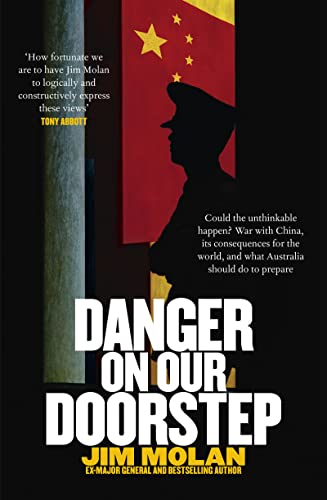Australian Defence in a New Strategic Context: The Perspective of Jim Molan
In my own book on Australian defence, I ended the book by including several interviews which I did in Canberra with Senator Jim Molan.
I did so because he provided an important perspective on the changing strategic situation facing the liberal democracies.
In a new book, Danger on Our Doorstep, Molan takes a hard look at the situation facing the United States and its allies in the Indo-Pacific region and draws conclusions about how Australia needs to rethink its defense and how to prepare for a situation in which the United States might not be able to defend effectively against a significant and widespread attack by China on the U.S. forces in the region.
He provides a realistic look at the impact of 20 years of focus on the land wars in the Middle East by the United States and how that has impacted on U.S. capabilities as well as defense propensities.
As he notes: “The US is surfacing from decades of war in the Middle East with worn-out equipment, understandably having allocated a lot of its funding to ‘today’s wars’ rather than investing in the future.
“During the Iraq War, for instance, Secretary of Defense Bob Gates wanted more drones to carry on the day-to-day fight in Iraq and found himself in conflict with the US Air Force, which wanted to continue building the fighters and bombers that it thought would be needed in the future.
“Gates sacked the chief of the US Air Force and restricted the production of aircraft such as the stealth F-22 fighter and the B-21 bomber, in order to build the drones and other aircraft he needed. The result was that only a limited number of the extraordinary F-22s were built and the B-21 is still not in production. The impact of diverted spending and focus will be felt for a long time to come.”
What does Australia need to do to prepare for a more robust defense of the nation in which Chinese aggression and capabilities increase and the United States struggles to rebuild its military capabilities?
Although this is a book focused on Molan highlighting for his own nation the need to build out a credible national security strategy, it is also a strategic warning about what the Chinese-American competition might shape in terms of realistic options for the future of Australia.
As he warns: “The prospect of a war in the Western Pacific is dark enough for the US, but it is even darker for Australia, with our one-shot defence force, our enormous vulnerability as a nation if we or the US cannot control the seas over which we import products such as fuel, pharmaceuticals, fertiliser and hundreds of other critical items, and over which we export the natural resources that make us prosperous.
“The weakness of our once great and powerful ally will change just about every aspect of life in Australia. In the very short time that China might take to move from its peacetime routine to a wartime footing, Australia will not be able to make any substantial advancements to its military capability or its national resilience. So now is the time for Australia to act. Or have we already left it too late?”
He argues that Australia needs to focus on a significant re-focus on national resilience, security and relevant national defense capabilities to prevail in the decade ahead.
Molan identifies key tasks which Australia must address.
First is to create a comprehensive national security strategy.
Second is to continue addressing shortfalls associated with problems posed by the legacy national security policies.
Third is the requirement to take the Chinese military threat seriously and to think through ways to enhance national resilience, warfighting and deterrence of China.
The fourth is to develop core capabilities to compete effectively in gray zone conflicts.
The fifth is to fund the national security strategy and provide for the most relevant capabilities or as he puts this, to fund defense according to need.
He concludes: “The time for complacency for Australians is over, and now the task is to build real strength. While those engaged in strategic and military policy are fond of talking about an ‘uncertain strategic environment’, we now have a better understanding than ever of our potential strategic threats. China – either in concert with others or alone – is capable of challenging the US, dominating the Western Pacific and harming Australia’s interests to the extent that Australia as a liberal democracy is in danger, so preparing for a China war must be the standard we judge ourselves by.”
He underscores: “In the face of China’s aggression, Australian governments must continue to lead decisively on national security, and the Australian people must support moves to protect national sovereignty and promote resilience.
“This requires action on many fronts, especially using diplomacy to encourage US strength and deter China’s adventurism. It must also include strengthening our economy so it can absorb the shock of conflict and, most importantly, making the ADF larger, more potent and more capable of fighting for an extended period.
“Only a complete package, as the result of a national security strategy that creates self-reliance and resilience, will give Australia a real chance of deterring the conflict that we do not want. War is a terrible thing. But the only thing that is worse is being involved in a war and losing.”
I am looking forward to discussing his new book when I go to Australia next month. It is an important book for Americans as well as Australians.

